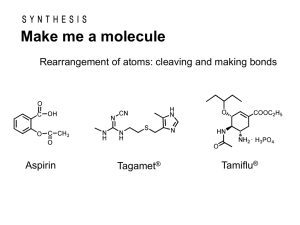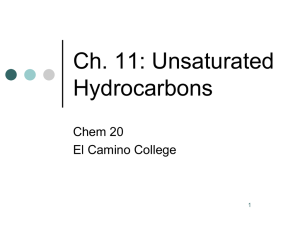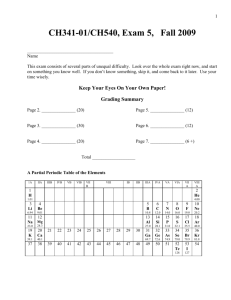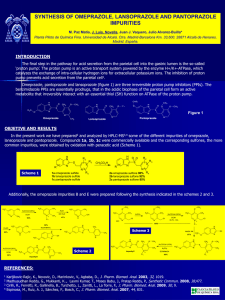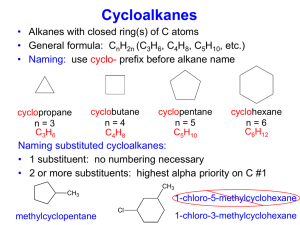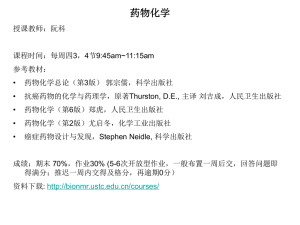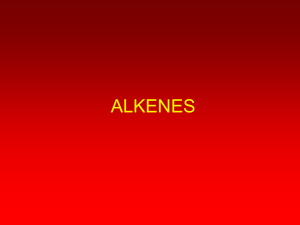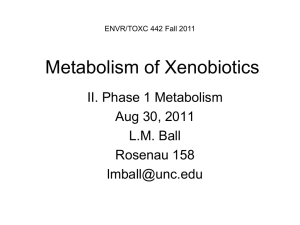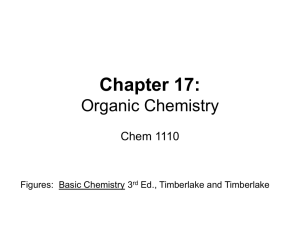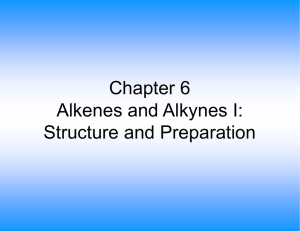Alkenes - chemistry
advertisement
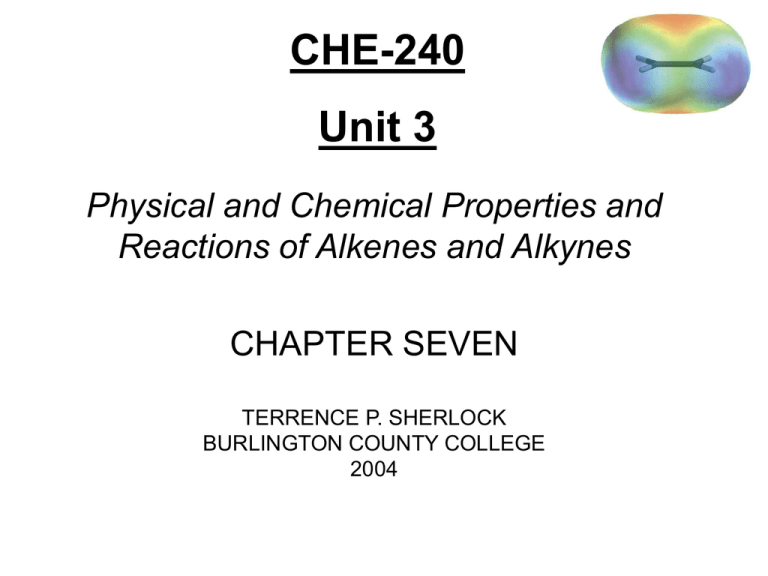
CHE-240 Unit 3 Physical and Chemical Properties and Reactions of Alkenes and Alkynes CHAPTER SEVEN TERRENCE P. SHERLOCK BURLINGTON COUNTY COLLEGE 2004 Orbital Description • • • • • Sigma bonds around C are sp2 hybridized. Angles are approximately 120 degrees. No nonbonding electrons. Molecule is planar around the double bond. Pi bond is formed by the sideways overlap of parallel p orbitals perpendicular to the plane of the molecule. => Chapter 7 2 Pi Bond • Sideways overlap of parallel p orbitals. • No rotation is possible without breaking the pi bond (63 kcal/mole). • Cis isomer cannot become trans without a chemical reaction occurring. => Chapter 7 3 Elements of Unsaturation • A saturated hydrocarbon: CnH2n+2 • Each pi bond (and each ring) decreases the number of H’s by two. • Each of these is an element of unsaturation. • To calculate: find number of H’s if it were saturated, subtract the actual number of H’s, then divide by 2. => Chapter 7 4 Propose a Structure: for C5H8 • First calculate the number of elements of unsaturation. • Remember: A double bond is one element of unsaturation. A ring is one element of unsaturation. A triple bond is two elements of unsaturation. => Chapter 7 5 Heteroatoms • Halogens take the place of hydrogens, so add their number to the number of H’s. • Oxygen doesn’t change the C:H ratio, so ignore oxygen in the formula. • Nitrogen is trivalent, so it acts like half a carbon. H H H C C N C H H H H Chapter 7 => 6 Structure for C6H7N? • Since nitrogen counts as half a carbon, the number of H’s if saturated is 2(6.5) + 2 = 15. • Number of missing H’s is 15 – 7 = 8. • Elements of unsaturation is 8 ÷ 2 = 4. => Chapter 7 7 IUPAC Nomenclature • Parent is longest chain containing the double bond. • -ane changes to -ene. (or -diene, -triene) • Number the chain so that the double bond has the lowest possible number. • In a ring, the double bond is assumed to be between carbon 1 and carbon 2. => Chapter 7 8 Name These Alkenes CH2 CH CH2 CH3 1-butene CHCH2CH3 CH3 C CH CH3 CH3 H3C 2-sec-butyl-1,3-cyclohexadiene 2-methyl-2-butene CH3 3-n-propyl-1-heptene 3-methylcyclopentene => Chapter 7 9 Name these: H CH3 Br C C CH3CH2 Br C C H H trans-2-pentene H cis-1,2-dibromoethene => Chapter 7 10 E-Z Nomenclature • Use the Cahn-Ingold-Prelog rules to assign priorities to groups attached to each carbon in the double bond. • If high priority groups are on the same side, the name is Z (for zusammen). • If high priority groups are on opposite sides, the name is E (for entgegen). => Chapter 7 11 Example, E-Z 1 1 H3C Cl C C H 2Z 1 H CH2 2 2 Cl 2 CH CH3 C C H 2 1 5E (2Z, 5E)-3,7-dichloro-2,5-octadiene => Chapter 7 12 Commercial Uses: Ethylene => Chapter 7 13 Commercial Uses: Propylene => Chapter 7 14 Other Polymers => Chapter 7 15 Substituent Effects • More substituted alkenes are more stable. H2C=CH2 < R-CH=CH2 < R-CH=CH-R < R-CH=CR2 < R2C=CR2 unsub. < monosub. < disub. < trisub. < tetra sub. • Alkyl group stabilizes the double bond. • Alkene less sterically hindered. => Chapter 7 16 Cycloalkene Stability • Cis isomer more stable than trans. • Small rings have additional ring strain. • Must have at least 8 carbons to form a stable trans double bond. • For cyclodecene (and larger) trans double bond is almost as stable as the cis. => Chapter 7 17 Alkene Synthesis Overview • • • • E2 dehydrohalogenation (-HX) E1 dehydrohalogenation (-HX) Dehalogenation of vicinal dibromides (-X2) Dehydration of alcohols (-H2O) => Chapter 7 18 Removing HX via E2 • Strong base abstracts H+ as X- leaves from the adjacent carbon. • Tertiary and hindered secondary alkyl halides give good yields. • Use a bulky base if the alkyl halide usually forms substitution products. => Chapter 7 19 Some Bulky Bases CH3 H3C _ CH(CH3)2 C O N CH3 H tert-bu toxi de CH(CH3)2 H3C di i sopropyl am i n e N CH3 2,6-di m e th yl pyri di n e (CH3CH2)3N : triethylamine => Chapter 7 20 Hofmann Product • Bulky bases abstract the least hindered H+ • Least substituted alkene is major product. H CH3 CH3 C C CH2 H Br H _ CH3CH2O CH3 CH3CH2 H3C C C C C CH3CH2OH CH3 H CH3 C C CH2 H Br H _ (C H3)3C O CH3CH2OH H H3C 71% H CH3 H 29% CH3 CH3CH2 H3C C C C C H CH3 28% Chapter 7 H H3C => H 72% 21 E2: Cyclohexanes Leaving groups must be trans diaxial. => Chapter 7 22 E2: Vicinal Dibromides • Remove Br2 from adjacent carbons. • Bromines must be anti-coplanar (E2). • Use NaI in acetone, or Zn in acetic acid. I - Br CH3 H CH3 Br H H3C H Chapter 7 C C CH3 H => 23 Removing HX via E1 • • • • Secondary or tertiary halides Formation of carbocation intermediate Weak nucleophile Usually have substitution products too => Chapter 7 24 Dehydration of Alcohols • Reversible reaction • Use concentrated sulfuric or phosphoric acid, remove low-boiling alkene as it forms. • Protonation of OH converts it to a good leaving group, HOH • Carbocation intermediate, like E1 • Protic solvent removes adjacent H+ =>25 Chapter 7 Dehydration Mechanism H H O H C C H O H O H O S C C O H _ HSO4 O H H O H H C C C C Chapter 7 H2O: C C => + H3O 26 POWER POINT IMAGES FROM “ORGANIC CHEMISTRY, 5TH EDITION” L.G. WADE ALL MATERIALS USED WITH PERMISSION OF AUTHOR PRESENTATION ADAPTED FOR BURLINGTON COUNTY COLLEGE ORGANIC CHEMISTRY COURSE BY: ANNALICIA POEHLER STEFANIE LAYMAN CALY MARTIN Chapter 7 27

